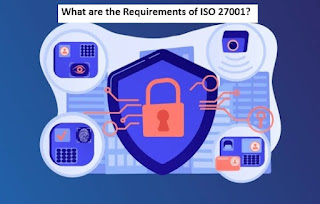For information security management systems (ISMS), ISO 27001
continues to be the industry standard. As technology and cyber threats change
in 2025, the standard still places a strong emphasis on modern controls,
proactive risk management, and strong security measures. The main requirements
of ISO 27001 are examined in this post, which also emphasizes the importance of
compliance for businesses.
Understand the ISO 27001 Standard
An ISMS must be established, implemented, maintained and
continuously improved upon with ISO/IEC 27001. Organizations can manage risks,
safeguard their information assets, and show that they are in compliance with
legal and regulatory requirements due to the framework.
ISO 27001 Core Requirements
Organizational Context: Companies need to determine which internal and
external issues are pertinent to their ISMS. It is essential to comprehend the
requirements and expectations of all parties involved, including stakeholders,
customers, and regulators. This part makes sure that the organization's
strategic goals and the ISMS are in line.
Dedication to Leadership: Involving the leadership is essential to developing
an information security culture throughout the company. Top management have to
show their dedication and leadership by:
· Establishing the policy for ISMS.
· Allocating sufficient funds.
· Making sure corporate objectives and ISMS goals are in line.
· Encouraging ongoing development.
Risk Assessment and Management: An essential component of ISO 27001
is risk management. Organizations need to;
· Assess and identify information security weaknesses.
· Create and carry out plans for treating risks.
· To handle new threats, review and update risk assessments on regularly.
Annex A Control: A comprehensive list of security measures organized into
areas including incident management, cryptography, and access control is given
in Annex A. New controls for the following are included in the version.
· Cloud protection
· Risks of Artificial Intelligence (AI)
· Weakness in the Internet of Things (IoT)
Goals of Information Security: To make sure that ISMS is in line
with company priorities, specific, quantifiable goals must be established.
Reducing incidents, speeding up responses, or complying with regulations are a
few examples.
Assistance and Materials: The company needs to;
· Give the ISMS the resources it needs.
· Make sure staff members are properly trained and skilled.
· Keep thorough records and documents.
Operation and Assessment of Performance: Organizations need to make sure that
ISMS runs well by;
· Frequent measurement and observation
· Completing internal audits.
· Carrying out management evaluations
Constant Improvement: Continuous improvement is emphasized by ISO 27001 to
strengthen security measures and adjust to new dangers. Non-conformities must
be addressed quickly by corrective measures, which should concentrate on
avoiding recurrence.
The Significance of ISO 27001 Compliance
· Reducing Online Dangers: Organizations can proactively address vulnerabilities and avoid attacks by adhering to ISO 27001.
· Adherence to Regulations: By ensuring adherence to data protection laws like GDPR, conformity lowers the possibility of fines.
· Establishing Credibility: An ISO 27001 certification boosts stakeholder and customer confidence by demonstrating a dedication to information security.
· A Competitive Edge: Being certified by ISO 27001 differentiates businesses and gives them a big advantage in a market where security is a top concern.
ISO 27001 is still an essential tool for risk management in
information security in 2025. Following its guidelines helps businesses protect
their data, keep up with new technology, and become more resilient to ever
changing cyber threats. ISO 27001
training courses
will give you a thorough understanding of the ISMS audit procedure and the
procedures for the most recent ISO/IEC 27001:2022 certification. It is more
important than ever to comply with ISO 27001 to preserve confidence and ensure
success in the more complex digital world.
Source Link: https://27001securitycertification.wordpress.com/














